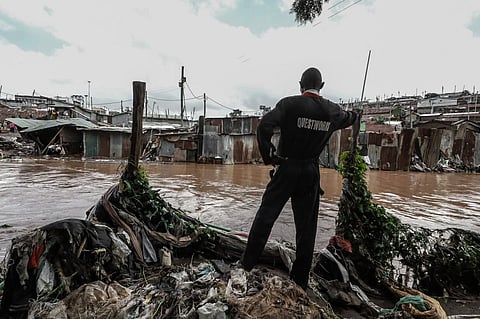

The death toll from the ongoing floods in Kenya has hit 38, with over 110,000 people displaced by the morning of April 24, 2024, according to government officials and the Kenya Red Cross. Property, including farmlands and road networks worth millions of shillings, have been destroyed.
March marked the beginning of the long rainy season (March to May), which has been characterised by deadly and destructive flash floods in April. The floods have resulted in the bursting of rivers, damage to key infrastructure like hospitals, loss of livestock and restricted access to some major highways / roads across the country.
“It’s unfortunate that we have lost 38 people to the ongoing floods and over 110,000 individuals have been affected through displacements. It’s also regrettable that some Kenyans are disregarding the precautions we are issuing,” said Venant Ndighila, head of disaster operations, Kenya Red Cross.
“We, for instance, issued over 19 million text messages to likely victims in flood-prone regions since February but we continue to see people wade through floodwaters, attempt to cross swollen rivers, drive through flood waters as they expose themselves to danger,” added Ndighila.
While acknowledging the floods are the result of multiple factors, including climate change in Kenya, Ndinghila mourned the deaths and destruction of property. In parts of the central Kenya region, rice fields are flooded with rainwater and in other instances, the maize crop has been swept away by raging floods.
Authorities are concerned that prolonged, large-scale crop loss, especially in key regions considered as breadbaskets like central and western Kenya and Rift Valley regions, is likely to result in food security challenges for a country that is already straining to feed its citizens.
“We have lost everything, including the little food we had in stores. Everything has been swept away. Houses are uninhabitable, some local schools and hospitals have been marooned,” Annette Akinyi, a peasant rice farmer in Ahero Plains in western Kenya, told local journalists as she waded through a pool of floodwater outside her house.
The Kenya Red Cross has warned the situation is rapidly spiralling out of control and degenerating from an emergency to a disaster that might have far-reaching health and nutrition implications. The Kenyan authorities and humanitarian agencies have warned residents living in lowlands prone to flashfloods to move to raised and safer lands, even as the Kenya Meteorological Department warned of increased rainfall in the next week.
The director of meteorological services, David Gikungu, warned that the rains will get worse in the remaining weeks of April and early May. The March to May period is the major rainfall season (long rains) in Kenya and parts of eastern Africa, according to Gikunga.
“The highest volumes of seasonal rainfall (greater than 300mm) are experienced around this period,” said Gikungu, adding that the gradual enhancement of April rains and floods are attributed to multiple climate drivers.
Heavy rains and floods in Kenya during April are not uncommon, as the country typically experiences two rainy seasons: The long rains from March to May and the short rains from October to December, he said. “However, climate change has exacerbated these weather patterns, leading to more intense and unpredictable rainfall.”
“Several factors contribute to the increased flooding witnessed in Kenya and many other regions around the world. Climate change leads to warmer temperatures, which can cause more water vapour to evaporate into the atmosphere, leading to heavier rainfall events,” said Gikungu. Additionally, changing weather patterns alter the distribution of rainfall, resulting in prolonged dry spells followed by sudden heavy downpours, increasing the risk of flooding, Gakunga added.
In the northern, western and eastern parts of the country, huge chunks of key road networks have been destroyed, with some rural outposts now cut off from basic supplies, according to the Kenya Red Cross Society.
In Nairobi, one of the worst-hit areas in the country, the authorities are busy carrying out rapid response operations, following the death of 11 people in the last 24 hours. So far, the floods have displaced over 10,000 people after the heavy rain submerged homes in Nairobi’s sprawling informal settlements, according to the Kenya Red Cross Society.
The situation is similar across the country. Communities living in low-lying areas or beside waterbodies have been requested to evacuate to safer grounds, even as the Kenya Meteorological Department warned of worse floods in the coming days.